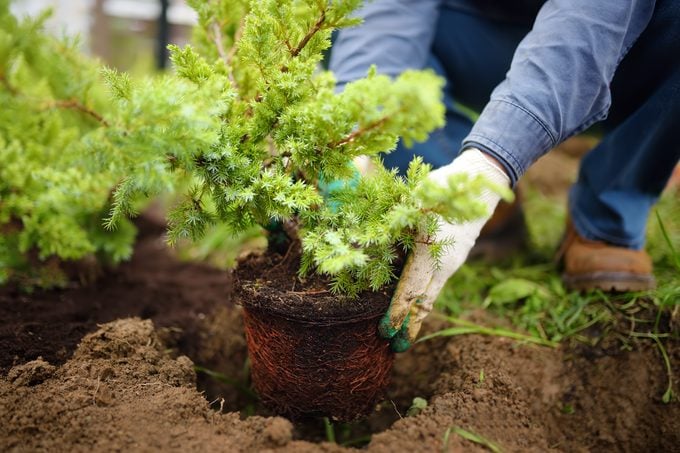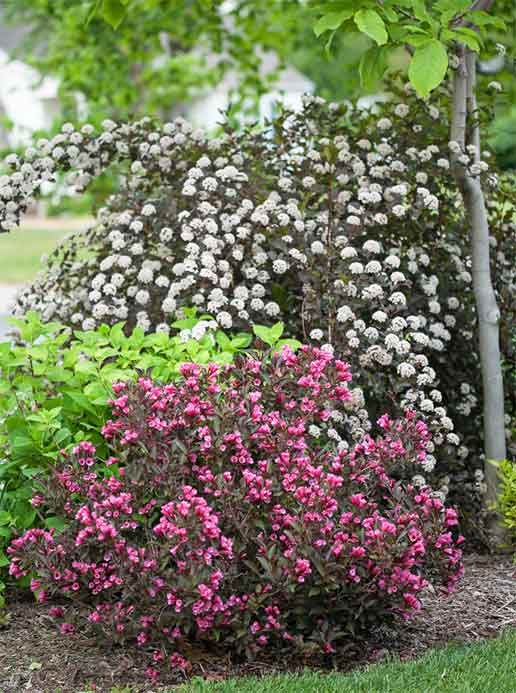How to Plant Shrubs and Bushes
Updated: Jan. 26, 2022
Planting shrubs will give you privacy and beautify your backyard in no time at all. Learn how to plant shrubs to help them grow and thrive.

The simple shrub—it can work wonders in your yard. Whether it’s structure, privacy, color or wildlife you seek, there’s a shrub to fill every need. Growing on a smaller scale than trees, shrubs are easier to manage and more admirable at eye level. Their size also means it’s easier to find spots for them in an existing landscape, and they won’t create large areas of unwanted shade. As an added bonus, you get to enjoy their appearance year-round. Follow these steps to learn how to plant shrubs.
How to Choose Shrubs to Plant
Do a little homework first. Find out which shrubs meet your needs. Maybe you’re looking for foundation plantings around your house, a colorful autumnal or early springtime show, security around windows or varieties that produce berries for the birds. Whatever you seek, ask the experts at your local nursery, check plant tags, surf the Internet, consult reference books or page through garden catalogs for recommendations.
Another way is to talk to your neighbors, especially those with shrubs you’ve admired. Ask if they can identify their beauties by variety, or at least direct you to the nursery where they purchased them. The advantage to this method is that you’ll already know it grows well in your area. Also look for alternatives to invasive shrubs.

Where to Plant Shrubs
Take a walk around your property and determine where shrubs may fit in. Where are the gaps? Where would brilliant color or the unique form of a shrub be welcome?
The best time to assess these questions is before or after perennials and annuals have had their glory days. That way, you’re not distracted by their beautiful shows.
The next logical question is how to make room for them. Here are a few suggestions:
- Replace shrubs you don’t like. It sounds harsh, but if they’re overgrown or no longer excite you, it may be time to make way for something new.
- Plant shrubs in new areas. Look to the back of a flower border, for example. Maybe you want to install a hedge as a boundary line, or you may want to cover up your home’s foundation or the lower part of a deck.
- Steal some lawn. Every keen gardener has probably already done this once or twice. Making your lawn smaller by digging up some turf even reduces the regular upkeep!
- Look for full sun, or at least partial shade. Full shade, often created from trees directly above, stunts the growth of many shrubs and also creates a problem of competing root systems. Most often, long-established trees win.
- Avoid exposed sites. This leaves shrubs vulnerable. Full-on bright sun can dry or bleach-out leaf and flower color, especially in the South. Most shrubs do well in more moderate light conditions. Give them a break from the blazing heat of midday, whether it’s the shadow of your house or garage, or the dappled shade of nearby trees.
- Avoid windy areas. Exposing shrubs to wind stresses them out, causing them to wilt and struggle. Plus, wind strips off foliage that you want to stay on the plant as long as possible.
- Give shrubs growing room. Before breaking ground, consider a shrub’s eventual size. Make sure it has the elbow room to grow. Check out the top 10 dwarf conifers for small spaces.
How to Plant Shrubs
Planting shrubs isn’t as hard as you might think:
- Remove all tags, wires or ropes from the stems or trunk. These can kill the plant as it grows.
- Dig a hole at least two times wider than the diameter of the shrub’s root ball. But don’t dig deeper than the height of the root system. Otherwise, your plant will sink. Sunken planting holes collect water, and the plant’s health may decline.Before planting your shrub, remove any large rocks and debris before scratching the sides of the planting hole with your shovel. This makes it easier for roots to penetrate the surrounding soil.
- Don’t amend the soil. Since roots can extend well beyond the planting hole, it’s next to impossible to amend the entire root zone. Plus, if a plant’s roots enjoy the rich soil too much, they will not extend beyond the planting hole, eventually becoming rootbound.
- Loosen the roots of pot-bound, container-grown shrubs. After you’ve eased the plant out of the pot, use a sharp knife to make four slices in the root mass, from top to bottom at even intervals, about an inch deep. This severs any strangling roots and inspires new root growth, believe it or not!
- Place the shrub at the same depth it was growing in the container. The root ball should be level with or slightly above the surface of the ground.
- Backfill with the existing soil. When the hole is about three-quarters full, tamp the soil gently. Water the shrub heavily to eliminate air pockets. Finish filling the hole to ground level. Use excess soil to build a ring about 6 inches from the outside edge of the hole, creating a watering moat.
Discover 5 essential steps for tree planting success.
Watering Newly Planted Shrubs
Once your plant is in the ground, water it thoroughly. This settles the soil, ensuring good root-soil contact for better root development. Add enough water to moisten the top 6 to 12 inches of soil. Continue to keep the root zone moist but not soggy.
Shrubs need thorough but less frequent watering. Check newly planted shrubs growing in sandy soils or hot regions twice a week. Those in clay soils or cooler regions should be checked every 7 to 10 days. Psst—here’s 5 drought-tolerant shrubs for your garden.
Apply a layer of mulch around new plantings, but be careful not to pile it over the crowns of plants. Mulching helps conserve moisture, moderate soil temperatures and keep mowers and weed cutters away from the plants.
Looking for new blooming bushes? Check out shrubs with pink flowers, yellow flowers and white flowers.
